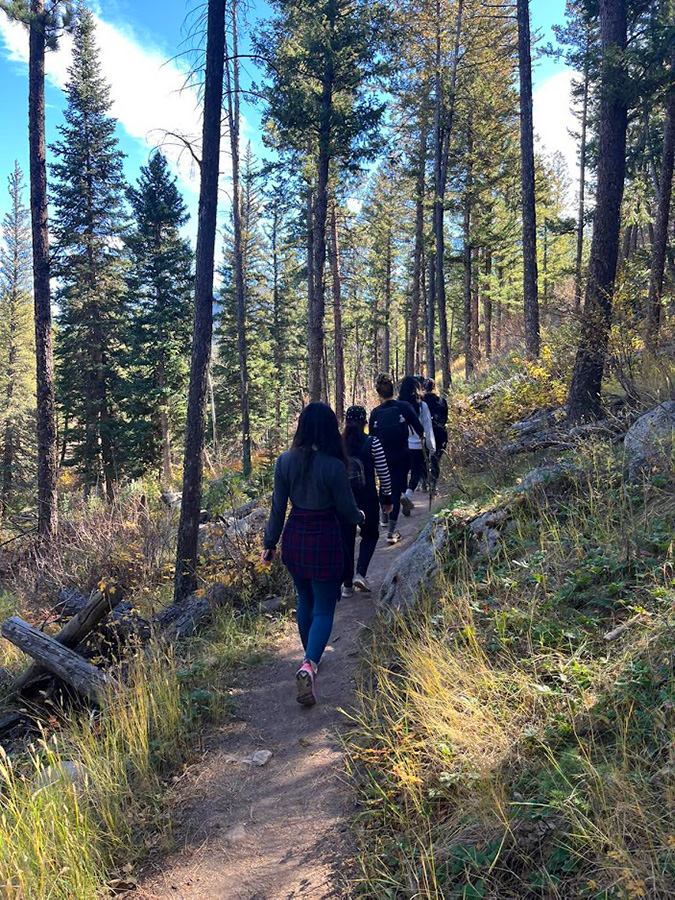In this photo, we’re somewhere along the boundary of Rocky Mountain National Park. The air smells of pine and juniper as we walk and talk and laugh. This particular hike is just about 3 miles long, but we’re up at nearly 8,000 feet, and our breath sometimes needs a minute to catch up to our legs. I keep thinking, “It is so good to be here.”
“Here” is Colorado, and “here” is a long-expected gathering of women from various Christian institutions across the U.S. We are a group of peers, all of us in similar career phases, all of us committed to the work of the church and the ways of Jesus.
As we met in this beautiful place, I felt that these few days together summed up so much of what the past few years have shown us — about the ways we all need each other, and about the many ways, traditional and not, we can show up when needed.
This peer group was very much a product of the pandemic. It came out of an idea I had in the fall of 2020 and spring of 2021, when I participated in the first-ever virtual cohort of Foundations of Christian Leadership. My idea was to gather a small group of women who had jobs like mine, the kinds of ministry-adjacent roles where it was sometimes difficult to find resources and support.
I’m not a pastor, and I don’t work at a church, but the faith-based work I do means that the usual nonprofit or higher ed resources don’t always seem to speak to my context. I proposed this group as a place for emerging female leaders in Christian institutions to come together and learn from each other. Colleagues recommended various women who fit my description — women who’d advised us on our programming, participated in our grant activities. Ultimately, 10 of them said yes.
We met on Zoom for the first time in July 2021 and continued to meet that way monthly. A virtual setting was the only way these particular participants, scattered across the country, could gather. There were 11 of us in all, spread out over seven states (plus D.C.) and three time zones. (To this day, all 11 of us have not been on one call at the same time!)
For as much talk of (and experience with) “Zoom fatigue” as there has been throughout the COVID-19 era, this online-only group was a boost and a gift each month. I realized fairly early on that we didn’t need much of an agenda for conversation — really profound conversation — to thrive. We saw the promise and wisdom in one another, and more often than not, I was able to just sit back from my screen and drink it all in.
We’d met online for eight months before I even brought up the possibility of gathering in person, an idea my supervisor and co-workers nudged me toward. Ultimately, seven of us found ourselves meeting at the Denver airport in October 2022, 15 months after we’d first met via computer screens. We made our way into the mountains and ate takeout pizza for dinner while sitting on the floor of my hotel room.
The next morning, a member of our group led us through a time of confessional Bible study, where we examined stories of women in the Bible and pondered them and the questions they stirred up in us.
That afternoon, another group member led us in a circle exercise, where each of us would have a few uninterrupted minutes to muse on questions like, “What does a favorite quote of yours mean to you?” and, “Who are you carrying with you this week?” Someone in the group brought out a box of Kleenex — which we would all need over the next hour.
Over a couple of shared days, we spotted elk and watched them through binoculars. We went for walks; we window-shopped; we popped into a bookstore and bought books we’d been recommending to each other (“Braiding Sweetgrass,” “Gilead”). We went out for dinner and split entrees that looked good but that we couldn’t decide on for ourselves. We marveled at the golden brightness of the aspen trees and their quaking leaves. We said we would do this again next year.
At dinner on the last night, we tried to figure out whether any of the seven of us had actually met in person before — had none of us ever run into each other? The answer was no.
The pandemic forced institutions and organizations to be pretty creative when it came to what was being done in person that could also be done online, whether schools or churches or offices. Now, as we emerge from the age of lockdowns and figure out how to live with COVID-19’s ongoing presence, we are rightly relieved that so much of our lives doesn’t have to be lived virtually anymore. But I also wonder what we might lose if, in that relief, we run too quickly away from the possibilities of online fellowship.
This Colorado gathering was so wonderfully embodied — when we all first rendezvoused at the airport, a common refrain was “You have legs! You’re more than just a head and shoulders!” — but the whole reason the gathering even happened was because we had built up connections beforehand, via (dare I say it) Zoom.
While together in person, we talked about how valuable this group was — and how safe it felt — precisely because none of us lived in the same place. We could bring concerns about our day-to-day lives in confidence, knowing that none of us would happen to run across the person or place being discussed. We could offer support in person because we’d built up the proper trust virtually, and that rhythm of support, in person and on screen, will continue.
I wrote in early 2021 about how the pandemic showed us how much we truly needed each other. Nearly two years later, that remains true — and we’ve also seen, in our COVID-era creativity, how we can forge and foster true community in so many ways. I don’t want to look back on the months of Zoom calls and say that it somehow wasn’t as real or as meaningful as it would have been if we could have met in person. I wouldn’t know these women if it weren’t for the tools that provided us a community in COVID-19’s darkest days.
I can’t wait to see them again on my laptop screen — and I can’t wait to go on another hike with them in person next year.



















